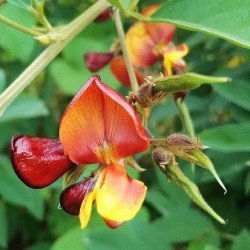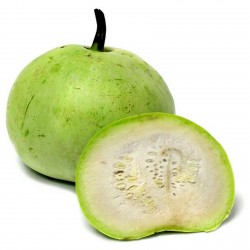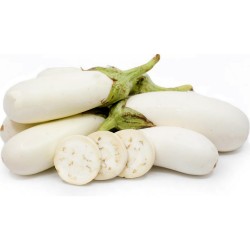
Indiából származó fajta


Galambborsó magok (Cajanus...
Ár
2,15 €
(SKU: VE 48)
Seeds Gallery EU,
5/
5
<h2><strong>Galambborsó magok (Cajanus cajan)</strong></h2>
<h2><span style="color: #ff0000;" class=""><strong>A csomag ára 10 (1.5g) mag.</strong></span></h2>
<p>A<span> </span><b>galambborsó</b><span> </span>(<i><b>Cajanus cajan</b></i>) évelő hüvelyes a<span> </span>pillangósvirágúak családjából. A háziasítása óta Indiában, legalább 3500 évvel ezelőtt, a magvai köznapi élelmiszergabonává váltak Ázsiában, Afrikában és Latin-Amerikában. Nagy arányban elsősorban<span> </span>Dél-Ázsiában fogyasztják, és jelentős fehérjeforrás az<span> </span>indiai szubkontinens lakossága számára.</p>
<h2><span class="mw-headline" id="Gyakori_elnevezések">Gyakori elnevezések</span></h2>
<p>A galambborsó számos neveken ismert különböző<span> </span>etimológiával.</p>
<h3><span class="mw-headline" id="India_nyelvein">India nyelvein</span></h3>
<ul>
<li><i>tubarika</i><span> </span>(तुबरिका) szanszkritban</li>
<li><i>togari bele<span> </span></i>(ತೊಗರಿ ಬೇಳೆ) a<span> </span>kannada nyelven</li>
<li><i>thuvaram paruppu</i><span> </span>(துவரம் பருப்பு)<span> </span>tamil nyelven</li>
<li><i>thuvara parippu</i><span> </span>(തുവരപ്പരിപ്പ്) a<span> </span>malajálam nyelven<sup id="cite_ref-1" class="reference">[1]</sup></li>
<li><i>tuver'</i><span> </span>(તુવેર) a<span> </span>gujarati</li>
<li><i>toor Dal</i><span> </span>(तूर डाळ)<span> </span>marathi</li>
<li><i>toor dal</i><span> </span>(तूर दाल) vagy<span> </span><i>arhar dal</i><span> </span>(अरहर दाल), két egyformán népszerű megnevezés a<span> </span>hindi nyelvben. Az eredeti szó hindi és más északi és keleti nyelven is <i>arhar,</i><span> </span>de a déli<span> </span><i>toor</i>-t már széles körben elfogadták az elmúlt körülbelül egy század alatt.</li>
<li><i>orhor dal</i><span> </span>(অড়হর ডাল) a<span> </span>bengáli nyelven</li>
<li><i>rohor dail</i><span> </span>(ৰহৰ দাইল)<span> </span>asszámi nyelven</li>
<li><i>rahar daal</i><span> </span>(रहर दाल)<span> </span>nepáli nyelven</li>
<li><i>harada dali</i><span> </span>az odia nyelven</li>
<li><i>kandi bedalu</i><span> </span>(కందిపప్పు) telugu nyelven</li>
<li><i>behliang</i><span> </span>a zomi/mizo nyelv</li>
<li><i>Towar<span> </span></i>vagy<i><span> </span>Tovar<span> </span></i>vagy<i><span> </span>Tover ki dal</i> gyakori vagy széles körben beszélt hindi és urdu Indiában</li>
</ul>
<h3><span id="M.C3.A1s_orsz.C3.A1gokban"></span><span class="mw-headline" id="Más_országokban">Más országokban</span></h3>
<ul>
<li><i>no-eye pea</i></li>
<li><i>tropical green pea</i></li>
<li><i>gungo pea</i> Jamaicában</li>
<li><i>gandule bean</i></li>
<li><i>gandul</i><span> </span>/<span> </span><i>guandu</i> Latin Amerikában</li>
<li><i>chícharo</i> Latin-Amerikában</li>
<li>"kumanda yvyra'i" Guaraní néven Paraguayban</li>
<li><i>arveja</i> Ecuadorban</li>
<li><i>mgbụmgbụ</i></li>
<li><i>gungo pea</i><span> </span>/<span> </span><i>gunga pea</i><span> </span>/<span> </span><i>Congo pea</i> Afrikában</li>
<li><i>mzimbili mussa</i> Tanzániában</li>
<li><i>nandolo</i> Malawiban</li>
<li><i>fio-fio</i></li>
<li><i>mbaazi</i> Kenyában</li>
<li><i>kadyos</i><span> </span>Fülöp-szigeteken</li>
<li><i>quinchoncho</i> Venezuelában</li>
<li>"mbaazi" Tanzániában</li>
</ul>
<h2><span id="Patog.C3.A9nek"></span><span class="mw-headline" id="Patogének">Patogének</span></h2>
<ul>
<li><i>Phytophthora cajani</i></li>
<li><i>Fitoplazma</i></li>
</ul>
<h2><span class="mw-headline" id="Fordítás">Fordítás</span></h2>
<p>Ez a szócikk részben vagy egészben a<span> </span><i>Pigeon pea</i><span> </span>című angol Wikipédia-szócikk<span> </span><span class="plainlinks">ezen változatának<span> </span>fordításán alapul.</span><span> </span>Az eredeti cikk szerkesztőit annak laptörténete sorolja fel. Ez a jelzés csupán a megfogalmazás eredetét jelzi, nem szolgál a cikkben szereplő információk forrásmegjelöléseként.</p>
<p></p>
<script src="//cdn.public.n1ed.com/G3OMDFLT/widgets.js"></script>
VE 48 (1.5g)






